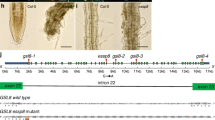Abstract
In barley (Hordeum vulgare L. cv. Herta), slender (sln1) is a single-locus recessive mutation which causes a plant to appear as if it had been grown in sturating concentrations of gibberellin (GA). We have investigated two of the GA-mediated processes in slender barley, shoot elongation and the induction of hydrolytic enzymes in aleurone layers. Shoot elongation is severely retarded in normal (wild-type) barley if the biosynthesis of GA is blocked by an inhibitor, ancymidol (α-cyclopropyl-α-(p-methoxyphenyl)-5-pyrimidinemethanol). However, the slender mutant continues to elongate in the presence of ancymidol. In isolated normal aleurone layers, the synthesis and secretion of α-amylase (EC 3.2.1.1), protease (EC 3.4) and nuclease (EC 3.1.30.2) are induced by exogenously applied GA3. However, in the aleurone layers of the slender mutant these enzymes are produced even in the absence of GA but their synthesis is still susceptible to inhibition by abscisic acid. Bioassays of half-seeds of the slender mutant and their normal siblings show no detectable differences in endogenous levels of GA-like substances. We suggest that the slender mutation allows competent tissues to express fully, or over-express, appropriate GA-induced processes independent of GA. We also conclude that shoot elongation, and hydrolytic-enzyme secretion in aleurone layers, share a common regulatory element.
Similar content being viewed by others
Abbreviations
- ABA:
-
abscisic acid
- GA:
-
gibberellin
- GA3 :
-
gibberellic acid
References
Boulger, M.C., Sears, R.G., Kronstad, W.E. (1982) An investigation of the association between dwarfing sources and gibberellic acid response in barley.Barley Genet IV, 566–570
Brown, P.H., Ho, D.T.-H. (1986) Barley aleurone layers secrete a nuclease in response to gibberellic acid. Plant Physiol. 82, 801–806
Chory, J., Voytas, D.F., Olszewski, N.E., Ausubel, F.M. (1987) Gibberellin-induced changes in the populations of translatable mRNAs and accumulated polypeptides in dwarfs of maize and pea. Plant Physiol. 83, 15–23
Chrispeels, M.J., Varner, J.E. (1967) Hormonal control of enzyme synthesis: On the mode of action of gibberellic acid and abscisin in aleurone layers of barley. Plant Physiol 42, 398–406
Coolbaugh, R.C., Hirano, S.S., West, C.A.(1978) Studies on the specificity and site of action of α-cyclopropyl-α-[p-methoxyphenyl]-5-pyrimidine methyl alcohol (ancymidol), a plant growth regulator. Plant Physiol. 62, 571–576
Foster, C.A. (1977) Slender: an accelerated extension growth mutant of barley. Barley Genet. Newslett. 7, 24–27
Ho, T.-H.D., Shih, S.C., Kleinhofs, A. (1980) Screening for barley mutants with altered hormone sensitivity in their aleurone layers. Plant Physiol. 66, 153–157
Ho, T.-H.D., Nolan, R.C., Shute, D.E. (1981) Characterization of a gibberellin-insensitive dwarf wheat, D6899. Plant Physiol. 67, 1026–1031
Hollenber, S.M., Giguere, V., Segue, P., Evans, R.M. (1987) Colocalization of DNA-binding and transcriptional activation functions in the human glucocorticoid receptor. Cell 49, 39–46
Jacobsen, J.V., Higgins, T.J.V. (1982) Characterization of the α-amylases synthesized by aleurone layers of Himalaya barley in response to gibberellic acid. Plant Physiol. 70, 1647–1653
Jacobsen, J.V. (1983) The regulation of protein synthesis in aleurone cells by gibberellin and abscisic acid. In: The biochemistry and physiology of gibberellins, pp. 159–187, Crozier, A., (ed.). Praeger, New York
Jacobsen, J.V., Beach, L.R. (1985) Control of transcription of α-amylase and rRNA genes in barley aleurone protoplasts by gibberellin and abscisic acid. Nature 316, 275–277
Jen, G., Thach, R.E. (1982) Inhibition of host translation in encephalomyocarditis virus-infected L cells: a novel mechanism. J. Virol. 43, 250–261
Jones, R.L. (1973) Gibberellins: their physiological role. Annu. Rev. Plant Physiol. 24, 571–598
Jones, R.L., Moll, C. (1983) Gibberellin-induced growth in excised lettuce hypocotyls. In: The biochemistry and physiology of gibberellins, pp. 95–157, Crozier, A., ed. Praeger, New York
Kakkis, E., Calame, K. (1987) A plasma cytoma-specific factor binds the c-myc promoter region. Proc. Natl. Acad. Sci. 84, 7031–7035
Laemmli, U.K. (1970) Cleavage of structural proteins during the assembly of the head of bacteriophage T4. Nature 227, 680–685
Lamprecht, H., (1948) The inheritance of the slender-type of Phaseolus vulgaris and some other results. Agri Hort. Genet. 5, 72–84
Lee, W.-H., Shew, J.-Y., Hong, F.D., Sery, T.W., Donoso, L.A., Young, L.-J., Bookstein, R., Lee, E. (1987) The retinoblastoma susceptability gene encodes a nuclear phospho-protein associated with DNA binding activity. Nature 329, 642–645
Mans, R.J., Novelli, G.D. (1960) A convenient, rapid, and sensitive method for measuring the incorporation of amino acids into protein. Biochem. Biophys. Res. Comm. 3, 540–548
Miesfeld, r., Godowski, P.J., Maler, B.A., Yamamoto, K.R. (1987)Glucocorticoid receptor mutants that define a small region sufficient for enhancer activation. Science236, 423–427
Nogi, Y., Shimada, H., Matsuzaki, Y., Hashimoto, H., Fukasawa, T. (1984) Regulation of the expression of the galactose gene cluster in Saccharomyces cerevisiae. Mol. Gen. Genet. 195, 29–34
Nolan, R.C., Lin, L.-S., Ho, D.T.-H. (1987) The effect of abscisic acid on the differential expression of α-amylase isozymes in barley aleurone layers. Plant Mol. Biol. 8, 13–22
Potts, W.C., Reid, J.B., Murfet, I.C. (1985) Internode length in Pisum. Gibberellins and the slender phenotype. Physiol. Plant. 63, 357–364
Riabaud, O., Schwartz, M. (1984) Positive control of transcription initiation in bacteria. Annu. Rev. Genet. 18, 173–206
Rogers, J.C. (1985) Two barley α-amylase genes are regulated differently in aleurone cells. J. Biol. Chem. 260, 3731–3738
Varner, J.E., Mense, R. (1972) Characteristics of the process of enzyme release from secretory plant cells. Plant Physiol. 40, 187–189
Varner, J.E., Ho, D.T.-H. (1976) The role of hormones in the integration of seedling growth. In: The molecular biology of hormone action, pp. 173–194, Papconstantinou J. ed. Academic New York
Author information
Authors and Affiliations
Rights and permissions
About this article
Cite this article
Lanahan, M.B., Ho, TH.D. Slender barley: A constitutive gibberellin-response mutant. Planta 175, 107–114 (1988). https://doi.org/10.1007/BF00402887
Received:
Accepted:
Issue Date:
DOI: https://doi.org/10.1007/BF00402887




